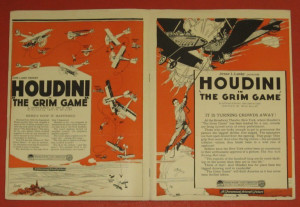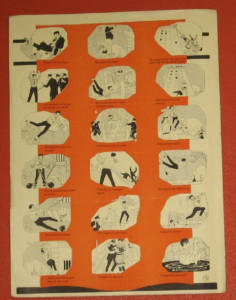Magicians interest in the movies was spurred by special promotion of The Grim Game for the magic community. Full-color four-page advertising inserts were published in the magic magazine M-U-M to accompany the release of The Grim Game [August 1919 pages 17-20 and September 1919 pages 29-32]. A special screening of the film was arranged for the Society of American Magicians (SAM), which gave The Grim Game its official endorsement and pledged that its members would help promote the film around the country [Sphinx September 1919 page 162].
At the 1919 SAM screening of The Grim Game, Thurston gave a speech in which he pronounced the film “one of the most wonderful things I have ever seen” and called it Houdini’s “greatest work” [quoted in Sphinx September 1919 page 162].
Houdini followed up The Grim Game with a second feature for Famous Players-Lasky entitled Terror Island. There was also some spectacular ads that accompanied the release of Terror Island in April 1920, that we will take a look at next week.
Source
- Magicians and the Magic of Hollywood Cinema during the 1920s by Matthew Solomon




Cool. Never heard that Thurston quote.
Where is this Solomon piece? Is it a magazine article?
It’s an essay that he wrote. You can find a copy of it in Chapter 3 of the book “Performing Magic on the Western Stage”.
How well did The Grim Game do at the box office? I don’t believe Terror Island grossed as well. This may have been one reason why he went solo in his film productions after Terror Island. Hollywood probably concluded Houdini wasn’t going to be a big draw and let him go. We know that Adolph Zukor, the Paramount mogul who produced and distributed TGG and TI, gave Harry the cold shoulder when he tried to get Zukor to distribute The Man From Beyond. Zukor wouldn’t even take Houdini’s phone calls.
According to Gresham, TGG had gross receipts of $150,000 with an additional $50,000 from foreign markets. TI earned a modest $111,000 in the U.S. plus another $54,000 overseas. At the time, typically the first-run gross of the average film with a popular star was $375,000.
So not counting foreign markets, Houdini’s drawing power for TTG fell $225,000 below the average film. You can see why Zukor didn’t bother to answer Houdini’s calls. Again, one wonders if Harry crunched these numbers and decided to continue in film knowing his drawing power fell below average.
It’s sad that Mr. Zukor would not return a phone call, since they were good friends at one time and both born in Hungary. According to Pat Culliton, they apparently played sports together at Morningside Park (near their Harlem homes) and both were involved in a Hungarian Aid charity during WW1. All this before Houdini’s movie career began.
Zukor is also reputed to have had monkey gland transplants, which we know Houdini had an interest in. And Zukor was also one of the honorary pallbearers at Houdini’s funeral.
Yes, it sounds cold but since you shared that information on their friendship, it sounds like Zukor didn’t want to deal with rejecting Houdini’s overtures. Kind of like a friend who jumps into selling Tupperware and starts to call you to purchase a set. You don’t really want to and you don’t want to say “No” either.
The bottom line is the almighty dollar and Zukor did not want to lay his money on the line to distribute another Houdini picture. This is how you know a box office star has reached the end of the line. Hollywood will not distribute, nor advertise their independently made films, which wind up going straight to DVD. This happened to Jean Claude Van Damme and Steven Seagal.
Sad but true.
“Houdini’s original contract with Famous Players called for only one picture, for although his ability in his particular line of work was acknowledged to be of the first order, its potential value as screen entertainment was a more or less uncertain quantity, especially so on the account of the fact that his picture experience had been limited to one serial. “ [The Motion Picture World, September 13, 1919]
They gave him a second chance with TI, but not a third chance with TMFB.